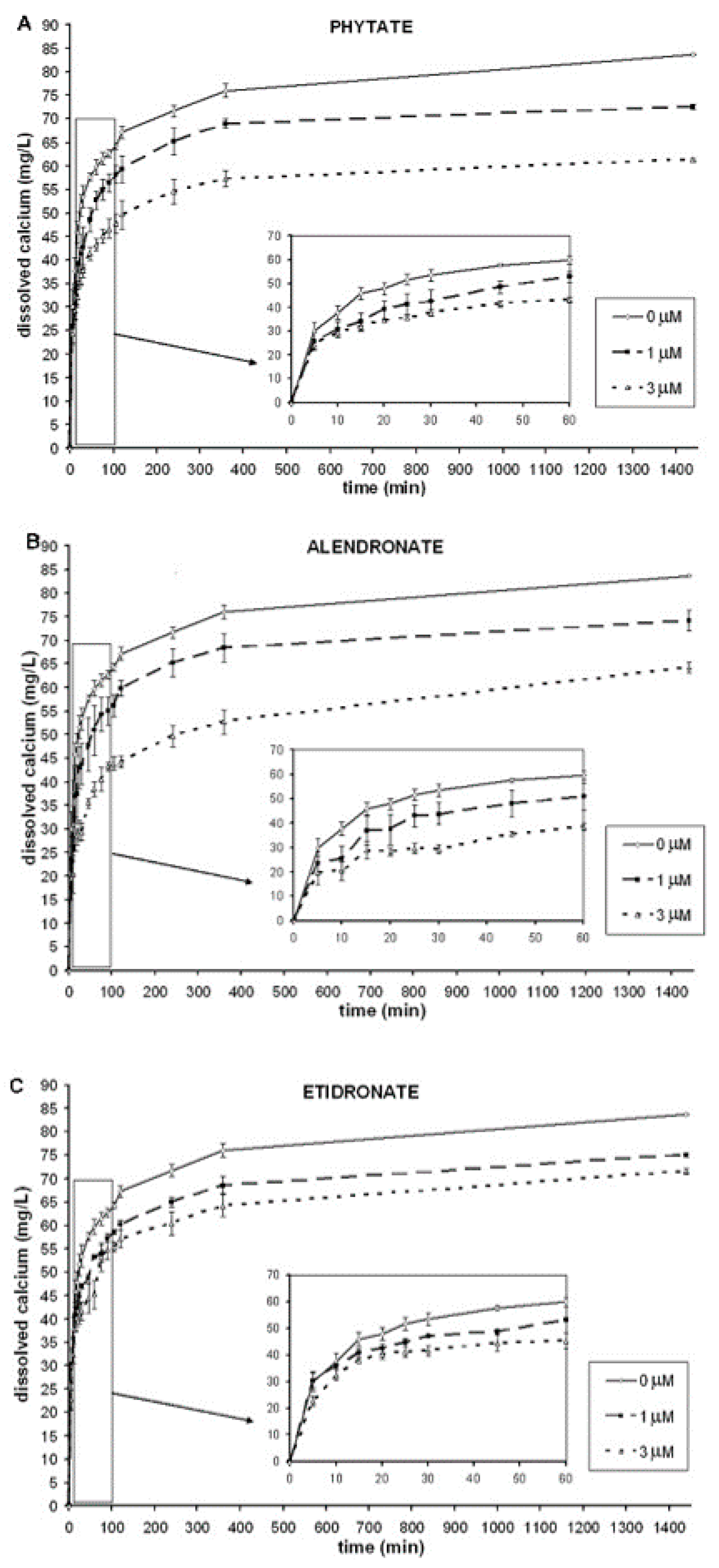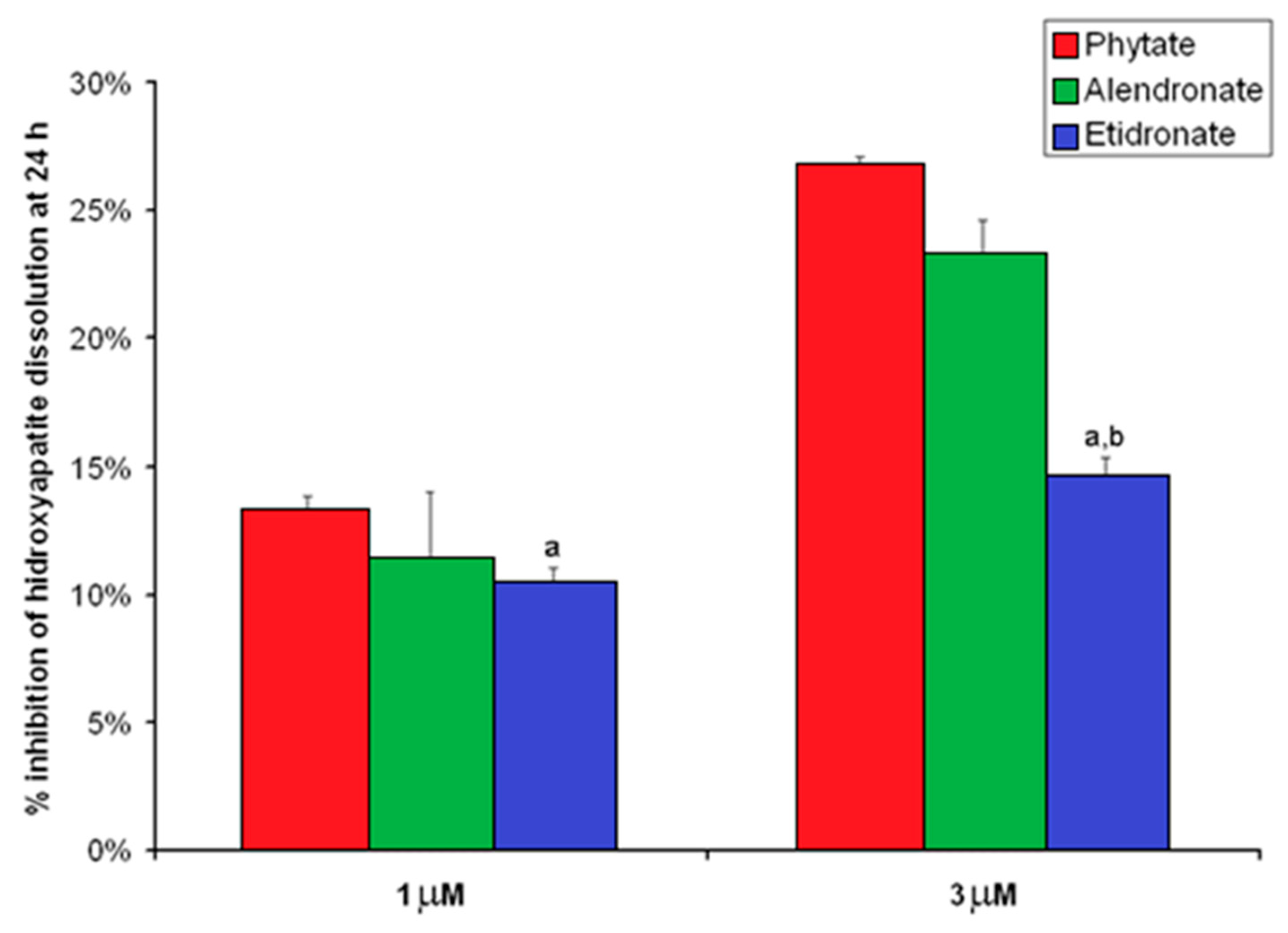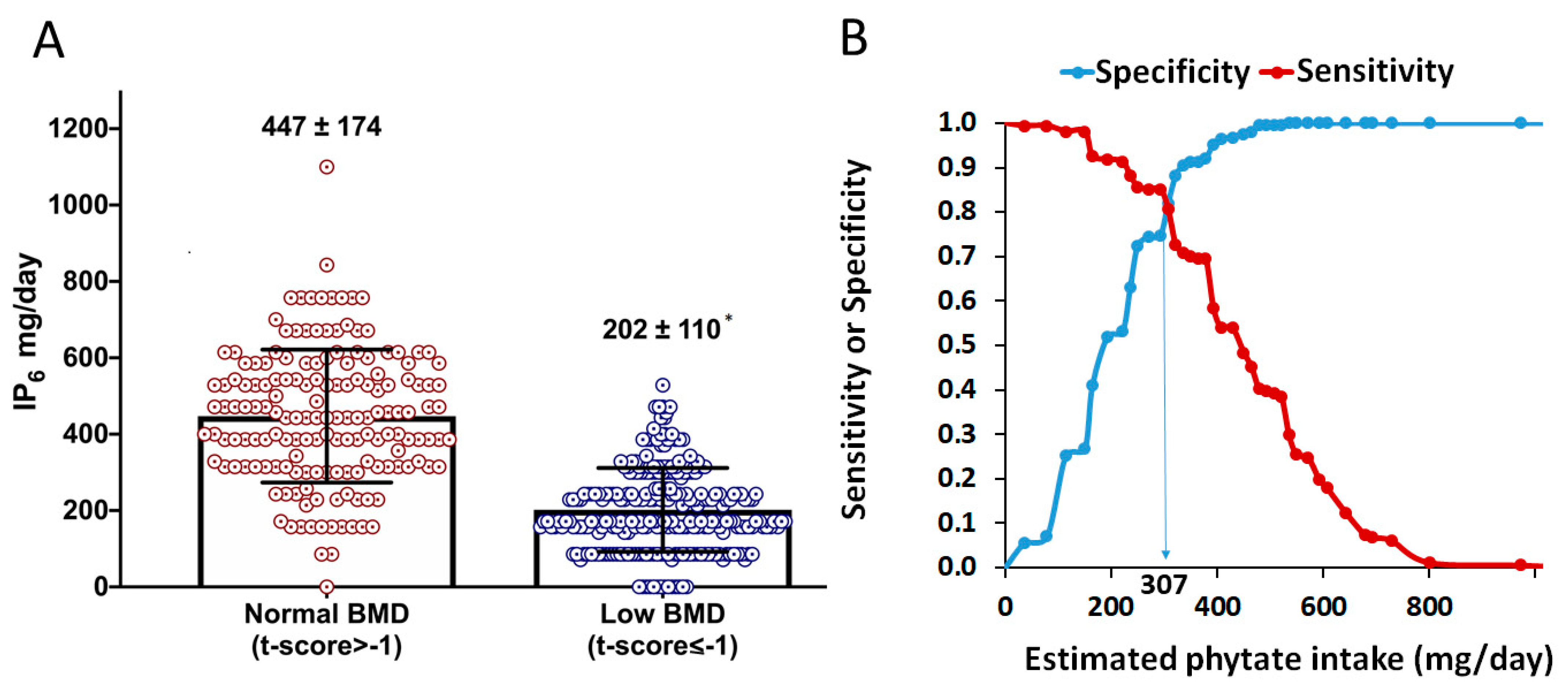Understanding the Protective Effect of Phytate in Bone Decalcification Related-Diseases
Abstract
1. Introduction
2. Materials and Methods
2.1. In-Vitro Study: Effects of IP6 on Dissolution of HAP
2.1.1. Adsorption of Phytate and Bisphosphonate on HAP Crystal
2.1.2. Inhibition of HAP Dissolution
2.2. Cross-Sectional Study: Association of Phytate and BMD
2.2.1. Subjects and Methods
2.2.2. Dietary Assessment, Estimation of Phytate Intake, and Mediterranean Diet Score
2.2.3. Determination of Bone Mineral Density
2.3. Statistical Analysis
3. Results
3.1. In-Vitro Study: Effects of IP6 on Dissolution of HAP
3.2. Cross-Sectional Study: Association of Phytate and BMD
4. Discussion
5. Conclusions
6. Patents
Author Contributions
Funding
Institutional Review Board Statement
Informed Consent Statement
Acknowledgments
Conflicts of Interest
References
- Fleisch, H.; Bisaz, S. Isolation from urine of pyrophosphate. A calcification inhibitor. Am. J. Physiol. 1962, 203, 671–675. [Google Scholar] [CrossRef]
- Fleisch, H.; Neuman, W.F. Mechanism of calcification: Role of collagen. polyphosphates. and phosphatases. Am. J. Phisiol. 1961, 200, 1296–1300. [Google Scholar] [CrossRef]
- Fleisch, H.A.; Russell, R.G.; Bisaz, S.; Muhlbauer, R.C.; Williams, D.A. The inhibitory effect of phosphonates on the formation of calcium phosphate crystals in vitro and on aortic and kidney calcification in vivo. Eur. J. Clin. Investig. 1970, 1, 12–18. [Google Scholar] [CrossRef] [PubMed]
- Fleisch, H.; Russell, R.G.; Francis, M.D. Diphosphonates inhibit hydroxyapatite dissolution in vitro and bone resorption in tissue culture and in vivo. Science 1969, 165, 1262–1264. [Google Scholar] [CrossRef] [PubMed]
- Russell, R.G.; Muhlbauer, R.C.; Bisaz, S.; Williams, D.A.; Fleisch, H. The influence of pyrophosphate. condensed phosphates. phosphonates and other phosphate compounds on the dissolution of hydroxyapatite in vitro and on bone resorption induced by parathyroid hormone in tissue culture and in thyroparathyroidectomised rats. Calcif. Tissue Res. 1970, 6, 183–196. [Google Scholar] [CrossRef] [PubMed]
- Fleisch, H. Bisphosphonates in bone disease. In From the Laboratory to the Patient, 3rd ed.; The Parthenon Publishing Group: New York, NY, USA, 1997. [Google Scholar]
- Drake, M.T.; Clarke, B.L.; Khosla, S. Bisphosphonates: Mechanism of action and role in clinical practice. Mayo Clin. Proc. 2008, 83, 1032–1045. [Google Scholar] [CrossRef] [PubMed]
- Fleisch, H.A. Bisphosphonates: Preclinical aspects and use in osteoporosis. Ann. Med. 1997, 29, 55–62. [Google Scholar] [CrossRef]
- Grases, F.; Simonet, B.M.; Prieto, R.M.; March, J.G. Variation of InsP4. InsP5. InsP6 levels in tissues and biological fluids depending on dietary phytate. J. Nutr. Biochem. 2001, 12, 595–601. [Google Scholar] [CrossRef]
- Grases, F.; Simonet, B.M.; Vucenik, I.; Prieto, R.M.; Costa-Bauzá, A.; March, J.G.; Shamsuddin, A.M. Absorption and excretion of orally administered inositol hexaphosphate (IP6 or phytate) in humans. BioFactors 2001, 15, 53–61. [Google Scholar] [CrossRef] [PubMed]
- Grases, F.; Isern, B.; Perelló, J.; Sanchis, P.; Prieto, R.M. Absorption of myo-inositol hexakisphosphate (InsP6) through the skin: Study of the matrix effects. Mechanism of phytate topical absorption. Front. Biosci. 2005, 10, 799–802. [Google Scholar] [CrossRef][Green Version]
- Grases, F.; Isern, B.; Perelló, J.; Sanchis, P.; Prieto, R.M.; Costa-Bauzá, A. Absorption of myo-inositol hexakisphosphate (InsP6) trough the skin in humans. Pharmazie 2006, 61, 652. [Google Scholar] [PubMed]
- Grases, F.; Prieto, R.M.; Simonet, B.M.; March, J.G. Phytate prevents tissue calcifications in female rats. BioFactors 2000, 11, 171–177. [Google Scholar] [CrossRef] [PubMed]
- Grases, F.; Perelló, J.; Prieto, R.M.; Simonet, B.M.; Torres, J.J. Dietary myo-inositol hexaphosphate prevents dystrophic calcifications in soft tissues: A pilot study in Wistar rats. Life Sci. 2004, 75, 11–19. [Google Scholar] [CrossRef]
- Grases, F.; Ramis, M.; Costa-Bauza, A. Effects of phytate and pyrophosphate on brushite and hydroxyapatite crystallization. Comparison with the action of other polyphosphates. Urol. Res. 2000, 28, 136–140. [Google Scholar] [CrossRef]
- Grases, F.; Costa-Bauza, A. Key Aspects of Myo-Inositol Hexaphosphate (Phytate) and Pathological Calcifications. Molecules 2019, 24, 4434. [Google Scholar] [CrossRef] [PubMed]
- Grases, F.; Isern, B.; Sanchis, P.; Perello, J.; Torres, J.J.; Costa-Bauza, A. Phytate acts as an inhibitor in formation of renal calculi. Front. Biosci. 2007, 12, 2580–2587. [Google Scholar] [CrossRef] [PubMed]
- Grases, F.; Perello, J.; Sanchis, P.; Isern, B.; Prieto, R.M.; Costa-Bauzá, A.; Santiago, C.; Ferragut, M.L.; Frontera, G. Anticalculus effect of a triclosan mouthwash containing phytate: A doubleblind. randomized. three-period crossover trial. J. Periodontal Res. 2009, 44, 616–621. [Google Scholar] [CrossRef] [PubMed]
- Grases, F.; Sanchis, P.; Perello, J.; Isern, B.; Prieto, R.M.; Fernandez-Palomeque, C.; Saus, C. Phytate reduces age-related cardiovascular calcification. Front. Biosci. 2008, 13, 7115–7122. [Google Scholar] [CrossRef]
- Sanchis, P.; Buades, J.M.; Berga, F.; Gelabert, M.M.; Molina, M.; Íñigo, M.V.; García, S.; Gonzalez, J.; Bernabeu, M.R.; Costa-Bauzá, A.; et al. Protective Effect of Myo-Inositol Hexaphosphate (Phytate) on Abdominal Aortic Calcification in Patients with Chronic Kidney Disease. J. Ren. Nutr. 2016, 26, 226–236. [Google Scholar] [CrossRef]
- Fernández-Palomeque, C.; Grau, A.; Perelló, J.; Sanchis, P.; Isern, B.; Prieto, R.M.; Costa-Bauzá, A.; Caldés, O.J.; Bonnin, O.; Garcia-Raja, A.; et al. Relationship between Urinary Level of Phytate and Valvular Calcification in an Elderly Population: A Cross-Sectional Study. PLoS ONE 2015, 10, 0136560. [Google Scholar] [CrossRef]
- Grases, F.; Sanchis, P.; Prieto, R.M.; Perelló, J.; López-González, Á.A. Effect of tetracalcium dimagnesium phytate on bone characteristics in ovariectomized rats. J. Med. Food 2010, 13, 1301–1306. [Google Scholar] [CrossRef]
- Gonzalez, A.A.L.; Grases, F.; Mari, B.; Tomas-Salva, M.; Rodriguez, A. Urinary phytate concentration and risk of fracture determined by the FRAX index in a group of postmenopausal women. Turk. J. Med. Sci. 2019, 49, 458–463. [Google Scholar] [CrossRef] [PubMed]
- López-González, A.A.; Grases, F.; Roca, P.; Mari, B.; Vicente-Herrero, M.T.; Costa-Bauzá, A. Phytate (myo-inositol hexaphosphate) and risk factors for osteoporosis. J. Med. Food 2008, 11, 747–752. [Google Scholar] [CrossRef] [PubMed]
- Arriero, M.M.; Ramis, J.M.; Perelló, J.; Monjo, M. Differential response of MC3T3-E1 and human mesenchymal stem cells to inositol hexakisphosphate. Cell Physiol. Biochem. 2012, 30, 974–986. [Google Scholar] [CrossRef]
- Arriero, M.M.; Ramis, J.M.; Perelló, J.; Monjo, M. Inositol hexakisphosphate inhibits osteoclastogenesis on RAW 264.7 cells and human primary osteoclasts. PLoS ONE 2012, 7, e43187. [Google Scholar] [CrossRef] [PubMed]
- Kanis, J.A.; Cooper, C.; Rizzoli, R.; Reginster, J.-Y.; on behalf of the Scientific Advisory Board of the European Society for Clinical and Economic Aspects of Osteoporosis (ESCEO); The Committees of Scientific Advisors and National Societies of the International Osteoporosis Foundation (IOF). European guidance for the diagnosis and management of osteoporosis in postmenopausal women. Osteoporos. Int. 2019, 30, 3–44. [Google Scholar] [CrossRef] [PubMed]
- Kitchin, B.; Morgan, S. Nutritional considerations in osteoporosis. Curr. Opin. Rheumatol. 2003, 15, 476–480. [Google Scholar] [CrossRef] [PubMed]
- Kontogianni, M.D.; Melistas, L.; Yannakoulia, M.; Malagaris, I.; Panagiotakos, D.B.; Yiannakouris, N. Association between dietary patterns and indices of bone mass in a sample of Mediterranean women. Nutrition 2009, 25, 165–171. [Google Scholar] [CrossRef] [PubMed]
- Rivas, A.; Romero, A.; Mariscal-Arcas, M.; Monteagudo, C.; Feriche, B.; Lorenzo, M.L.; Olea, F. Mediterranean diet and bone mineral density in two age groups of women. Int. J. Food Sci. Nutr. 2013, 64, 155–161. [Google Scholar] [CrossRef]
- Pérez-Rey, J.; Roncero-Martín, R.; Rico-Martín, S.; Rey-Sánchez, P.; Pedrera-Zamorano, J.D.; Pedrera-Canal, M.; López-Espuela, F.; Lavado García, J.M. Adherence to a Mediterranean Diet and Bone Mineral Density in Spanish Premenopausal Women. Nutrients 2019, 11, 555. [Google Scholar] [CrossRef] [PubMed]
- Calderon-Garcia, J.F.; Moran, J.M.; Roncero-Martin, R.; Rey-Sanchez, P.; Rodriguez-Velasco, F.J.; Pedrera-Zamorano, J.D. Dietary habits. nutrients and bone mass in Spanish premenopausal women: The contribution of fish to better bone health. Nutrients 2012, 5, 10–22. [Google Scholar] [CrossRef]
- Van Gelder, J.M.; Breuer, E.; Ornoy, A.; Schlossman, A.; Patlas, N.; Golomb, G. Anticalcification and antiresorption effects of bisacylphosphonates. Bone 1995, 16, 511–520. [Google Scholar] [CrossRef]
- Martínez-González, M.Á.; Corella, D.; Salas-Salvadó, J.; Ros, E.; Covas, M.I.; Fiol, M.; Wärnberg, J.; Arós, F.; Ruíz-Gutiérrez, V.; Lamuela-Raventós, R.M.; et al. PREDIMED Study Investigators. Cohort profile: Design and methods of the PREDIMED study. Int. J. Epidemiol. 2012, 41, 377–385. [Google Scholar] [CrossRef] [PubMed]
- Prieto, R.M.; Fiol, M.; Perello, J.; Estruch, R.; Ros, E.; Sanchis, P.; Grases, F. Effects of Mediterranean diets with low and high proportions of phytate-rich foods on the urinary phytate excretion. Eur. J. Nutr. 2010, 49, 321–326. [Google Scholar] [CrossRef] [PubMed]
- Harland, B.F.; Oberleas, D. Phytate in foods. World Rev. Nutr. Diet. 1987, 52, 235–259. [Google Scholar] [CrossRef]
- Schlemmer, U.; Frølich, W.; Prieto, R.M.; Grases, F. Phytate in foods and significance for humans: Food sources. intake. processing. bioavailability. protective role and analysis. Mol. Nutr. Food Rev. 2009, 53, S330–S375. [Google Scholar] [CrossRef] [PubMed]
- Harland, B.F.; Smikle-Williams, S.; Oberleas, D. High performance liquid chromatography analysis of phytate (IP6) in selected foods. J. Food Comp. Anal. 2004, 17, 227–233. [Google Scholar] [CrossRef]
- Maga, J.A. Phytate: Its chemistry occurrence, food interactions, nutritional significance, and methods of analysis. J. Agric. Food Chem. 1982, 30, 1–9. [Google Scholar] [CrossRef]
- Plaami, S. Myo-inositol phosphates: Analysis. content in foods and effects in nutrition. LWT Food Sci. Technol. 1997, 30, 633–647. [Google Scholar] [CrossRef]
- Buades, J.M.; Sanchis, P.; Perelló, J.; Grases, F. Plant phosphates, phytate and pathological calcifications in chronic kidney disease. Nefrologia 2017, 37, 20–28. [Google Scholar] [CrossRef][Green Version]
- López-González, A.A.; Grases, F.; Monroy, N.; Marí, B.; Vicente-Herrero, M.T.; Tur, F.; Perelló, J. Protective effect of myo-inositol hexaphosphate (phytate) on bone mass loss in postmenopausal women. Eur. J. Nutr. 2013, 52, 717–726. [Google Scholar] [CrossRef]
- Benetou, V.; Orfanos, P.; Pettersson-Kymmer, U.; Bergstrom, U.; Svensson, O.; Johansson, I.; Berrino, F.; Tumino, R.; Borch, K.B.; Lund, E.; et al. Mediterranean diet and incidence of hip fractures in a European cohort. Osteoporos. Int. 2013, 24, 1587–1598. [Google Scholar] [CrossRef]
- Feart, C.; Lorrain, S.; Ginder Coupez, V.; Samieri, C.; Letenneur, L.; Paineau, D.; Barberger-Gateau, P. Adherence to a Mediterranean diet and risk of fractures in French older persons. Osteoporos Int. 2013, 24, 3031–3041. [Google Scholar] [CrossRef] [PubMed]
- Holstein, S.A. A patent review of bisphosphonates in treating bone disease. Expert. Opin. Ther. Pat. 2019, 29, 315–325. [Google Scholar] [CrossRef] [PubMed]
- Ebetino, F.H.; Hogan, A.M.; Sun, S.; Tsoumpra, M.K.; Duan, X.; Triffitt, J.T.; Kwaasi, A.A.; Dunford, J.E.; Barnett, B.L.; Oppermann, U.; et al. The relationship between the chemistry and biological activity of the bisphosphonates. Bone 2011, 49, 20–33. [Google Scholar] [CrossRef] [PubMed]
- Cremers, S.; Drake, M.T.; Ebetino, F.H.; Bilezikian, J.P.; Russell, R.G.G. Pharmacology of bisphosphonates. Br. J. Clin. Pharmacol. 2019, 85, 1052–1062. [Google Scholar] [CrossRef] [PubMed]
- Rogers, M.J.; Mönkkönen, J.; Munoz, M.A. Molecular mechanisms of action of bisphosphonates and new insights into their effects outside the skeleton. Bone. 2020, 139, 115493. [Google Scholar] [CrossRef] [PubMed]
- Papapetrou, P.D. Bisphosphonate-associated adverse events. Hormones 2009, 8, 96–110. [Google Scholar] [CrossRef]
- Mellanby, E. Rickets-producing and anticalcifying action of phytate. J. Physiol. 1949, 109, 488–533. [Google Scholar] [CrossRef]
- Reddy, N.R.; Sathe, S.K.; Salunkhe, D.K. Phytates in legumes and cereals. Adv. Food Res. 1982, 28, 1–92. [Google Scholar] [CrossRef]
- Forbes, R.M.; Parker, H.M.; Erdman, J.W., Jr. Effects of dietary phytate. calcium and magnesium levels on zinc bioavailability to rats. J. Nutr. 1984, 114, 1421–1425. [Google Scholar] [CrossRef]
- Khokhar, S.; Pushpanjali, F.; Roger, G. Phytate content of Indian foods and intakes by vegetarian Indians of Hisar Region. Haryana State. J. Agric. Food Chem. 1994, 42, 2440–2444. [Google Scholar] [CrossRef]
- Zhou, J.R.; Wong, M.S.; Burns, R.A.; Erdman, J.W. Reduction of phytic acid in soy protein improves zinc bioavailibility. J. Nutr. 1992, 122, 2466–2473. [Google Scholar] [CrossRef] [PubMed]
- Grases, F.; Simonet, B.M.; Prieto, R.M.; March, J.G. Dietary phytate and mineral bioavailability. J. Trace Elem. Med. 2001, 15, 221–228. [Google Scholar] [CrossRef]
- Grases, F.; Simonet, B.M.; Perello, J.; Costa-Bauza, A.; Prieto, R.M. Effect of phytate on element bioavailability in the second generation of rats. J. Trace Elem. Med. 2004, 17, 229–234. [Google Scholar] [CrossRef]
- Walker, A.R.; Fox, F.W.; Irving, J.T. Studies in human mineral metabolism: 1. The effect of bread rich in phytate phosphorus on the metabolism of certain mineral salts with special reference to calcium. Biochem. J. 1948, 42, 452–462. [Google Scholar] [CrossRef] [PubMed]
- López-González, A.A.; Grases, F.; Marí, B.; Vicente-Herrero, M.T.; Costa-Bauzá, A.; Monroy, N. The influence of consumption of phytate on the bone mass in posmenopausal women of Mallorca. Reumatol. Clin. 2011, 7, 220–223. [Google Scholar] [CrossRef] [PubMed]
- Cullumbine, H.; Basnayake, V.; Lemottee, J.; Wickramanayake, T.W. Mineral metabolism on rice diets. Br. J. Nutr. 1950, 4, 101–111. [Google Scholar] [CrossRef]



| Low IP6 Intake | Moderate IP6 Intake | High IP6 Intake | p-Value | |
|---|---|---|---|---|
| (0–199) mg/Day | (200–325) mg/Day | >325 mg/Day | ||
| (n = 145) | (n = 127) | (n = 147) | ||
| Anthropometric parameters | ||||
| Age (years) | 56.6 ± 3.1 | 55.4 ± 2.7 a | 55.0 ± 2.4 a | <0.001 |
| BMI (kg/cm2) | 25.5 ± 4.2 | 25.5 ± 4.9 | 24.2 ± 3.7 a,b | 0.011 |
| Hip circumference (cm) | 106 ± 12 | 106 ± 13 | 102 ± 13 a | 0.019 |
| Waist Circumference (cm) | 89 ± 15 | 89 ± 15 | 86 ± 15 | 0.144 |
| Body Fat Mass (%) | 34.6 ± 9.1 | 34.2 ± 9.5 | 31.7 ± 9.5 a | 0.018 |
| Systolic Blood Pressure (mmHg) | 118 ± 15 | 120 ± 15 | 119 ± 15 | 0.468 |
| Diastolic Blood Pressure (mmHg) | 75 ± 10 | 75 ± 10 | 73 ± 11 | 0.140 |
| Dietary parameters | ||||
| Estimated Phytate Intake (mg/day) | 117 ± 54 | 268 ± 37 a | 499 ± 129 a,b | 0.032 |
| MedDiet Score (14-points) | 8.2 ± 1.6 | 8.9 ± 1.5 a | 9.7 ± 1.9 a,b | <0.001 |
| High Adherence to Med Diet (≥9 points) | 64 (44.1%) | 81 (65.9%) a | 108 (73.5%) a | <0.001 |
| Lumbar Spine L1–L4 | ||||
| Bone Mineral Density (g/cm2) | 0.69 ± 0.07 | 0.75 ± 0.07 a | 0.87 ± 0.09 a,b | <0.001 |
| t-score | −1.70 ± 0.44 | −1.31 ± 0.50 a | −0.44 ± 0.72 a,b | <0.001 |
| Low-BMD (t-score ≤ −1) | 132 (91.0%) | 92 (74.8%) a | 30 (20.4%) a,b | <0.001 |
| Normal-BMD | Low-BMD | p-Value | |
|---|---|---|---|
| (t-Score > −1) | (t-Score ≤ −1) | ||
| (n = 161) | (n = 254) | ||
| Anthropometric parameters | |||
| Age (years) | 55.0 ± 2.3 | 56.1 ± 3.1 | <0.001 |
| BMI (kg/cm2) | 24.5 ± 4.3 | 25.3 ± 4.2 | 0.052 |
| Hip Circumference (cm) | 103 ± 13 | 106 ± 13 | 0.035 |
| Waist Circumference (cm) | 87 ± 15 | 89 ± 15 | 0.087 |
| Body Fat Mass (%) | 32.1 ± 9.7 | 34.3 ± 9.2 | 0.022 |
| Systolic Blood Pressure (mmHg) | 119 ± 15 | 119 ± 14 | 0.991 |
| Diastolic Blood Pressure (mmHg) | 73 ± 10 | 75 ± 10 | 0.027 |
| BMD (g/cm2) | 0.88 ± 0.07 | 0.70 ± 0.06 | <0.001 |
| t-score | −0.33 ± 0.54 | −1.65 ± 0.38 | <0.001 |
| Dietary food intake | |||
| Vegetables (g/day) | 411 ± 217 | 351 ± 216 | 0.006 |
| Fruits (g/day) | 505 ± 258 | 417 ± 224 | <0.001 |
| Nuts (g/day) | 114 ± 61 | 35 ± 35 | <0.001 |
| Legumes (g/day) | 379 ± 193 | 312 ± 168 | <0.001 |
| Red Meat (g/day) | 74 ± 76 | 76 ± 73 | 0.828 |
| White meat (g/day) | 110 ± 40 | 110 ± 41 | 0.123 |
| Fish (g/day) | 296 ± 153 | 271 ± 142 | 0.092 |
| Olive Oil (g/day) | 30 ± 13 | 30 ± 15 | 0.656 |
| Butter (g/day) | 1.7 ± 5.8 | 0.6 ± 2.3 | 0.020 |
| Pastries and Sweets (g/day) | 76 ± 89 | 66 ± 90 | 0.259 |
| Carbonated Drinks (g/day) | 81 ± 154 | 72 ± 135 | 0.522 |
| Wine (g/day) | 87 ± 170 | 68 ± 153 | 0.234 |
| MedDiet Score. 14 points | 9.5 ± 1.8 | 8.6 ± 1.7 | <0.001 |
| Crude O.R. | 95% CI for (Crude O.R.) | p-Value | Adjusted * O.R. | 95% CI for (Adjusted * O.R.) | p-Value | |
|---|---|---|---|---|---|---|
| Estimated phytate intake | ||||||
| Tertile 1 (0–200 mg/day) | 1 | (reference) | <0.001 | 1 | (reference) | <0.001 |
| Tertile 2 (200–325 mg/day) | 0.29 | (0.15–0.59) | 0.001 | 0.32 | (0.16–0.66) | 0.002 |
| Tertile 3 (>325 mg/day) | 0.03 | (0.01–0.05) | <0.001 | 0.03 | 0.01–0.06 | <0.001 |
| Legumes (per servings/week) | 0.41 | (0.31–0.52) | <0.001 | 0.44 | 0.33–0.59 | <0.001 |
| Nuts (per servings/week) | 0.38 | (0.31–0.46) | <0.001 | 0.39 | 0.32–0.47 | <0.001 |
Publisher’s Note: MDPI stays neutral with regard to jurisdictional claims in published maps and institutional affiliations. |
© 2021 by the authors. Licensee MDPI, Basel, Switzerland. This article is an open access article distributed under the terms and conditions of the Creative Commons Attribution (CC BY) license (https://creativecommons.org/licenses/by/4.0/).
Share and Cite
Sanchis, P.; López-González, Á.-A.; Costa-Bauzá, A.; Busquets-Cortés, C.; Riutord, P.; Calvo, P.; Grases, F. Understanding the Protective Effect of Phytate in Bone Decalcification Related-Diseases. Nutrients 2021, 13, 2859. https://doi.org/10.3390/nu13082859
Sanchis P, López-González Á-A, Costa-Bauzá A, Busquets-Cortés C, Riutord P, Calvo P, Grases F. Understanding the Protective Effect of Phytate in Bone Decalcification Related-Diseases. Nutrients. 2021; 13(8):2859. https://doi.org/10.3390/nu13082859
Chicago/Turabian StyleSanchis, Pilar, Ángel-Arturo López-González, Antonia Costa-Bauzá, Carla Busquets-Cortés, Pere Riutord, Paula Calvo, and Felix Grases. 2021. "Understanding the Protective Effect of Phytate in Bone Decalcification Related-Diseases" Nutrients 13, no. 8: 2859. https://doi.org/10.3390/nu13082859
APA StyleSanchis, P., López-González, Á.-A., Costa-Bauzá, A., Busquets-Cortés, C., Riutord, P., Calvo, P., & Grases, F. (2021). Understanding the Protective Effect of Phytate in Bone Decalcification Related-Diseases. Nutrients, 13(8), 2859. https://doi.org/10.3390/nu13082859







